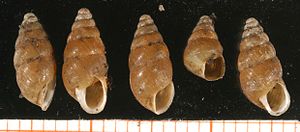Merdigera
| Merdigera | ||||||||||||
|---|---|---|---|---|---|---|---|---|---|---|---|---|

Lesser wolverine snail ( Merdigera obscura ) |
||||||||||||
| Systematics | ||||||||||||
|
||||||||||||
| Scientific name | ||||||||||||
| Merdigera | ||||||||||||
| Hero , 1838 |
Merdigera is a genus of the family of wolverines (Enidae) from the suborder of land snails (Stylommatophora).
features
The right-hand winding, egg-shaped-conical cases are 6.5 to 11 mm high and 3 to 4 mm wide. There are five to eight turns. The first turns are moderately convex at the periphery, the last turns are very flat. Young animals still have a cone-shaped housing with edged turns at the base. The mouth is egg-shaped and pointed at the top; the egg shape is inclined to the longitudinal axis of the housing. The whitish to light reddish mouth edges are only slightly bent and only slightly thickened. The mouth is toothless. The navel is shaped like a wide slit.
The housings are yellowish-horn-colored to chestnut brown. The shell is comparatively thin, the surface matt. The surface of the embryonic convolutions is smooth, the following convolutions have somewhat irregular radial folds or strips of growth.
In the sexual apparatus, the spermatic duct (vas deferens) separates early from the egg duct (sperm duct). It is thin, wrapped around the stem of the spermathec and the free fallopian tube or the vagina, and comparatively long. It opens apically into the very long epiphallus . A short to very short conical blind sack (flagellum) is formed at the confluence. The epiphallus is relatively thin to very thick, with a short to very short caecum in the middle. The actual penis is very short and strongly swollen at the epiphallus / penis junction, or about the same thickness as the epiphallus. The epiphallus is about twice to three times the length of the penis. This gradually decreases in thickness towards the opening into the atrium. The very long penile appendix sits just before the mouth or near the transition to the epiphallus, with a comparatively very short and thick lower part (A-1), a spherical-swollen part or an elongated-conical part (A-2) moderately long part with less thickness (A-3), a very thin middle part (A-4) and a club-shaped thickened end part (A-5). A-3 and A-4 merge and are difficult to distinguish. In the female genital tract, the free fallopian tube is very long and the vagina is very short. The stem of the spermathec is quite short, the small bladder comes to rest at about the lower end of the prostate. Shortly before the comparatively small bladder, a moderately long diverticulum branches off, which is more than twice as long as the rest of the stalk with the seminal vesicle.
Geographical distribution
The distribution area of the genus extends from northwest Africa over large parts of Europe to Central Asia (Uzbekistan). In the north it extends to Ireland, Scotland and southern Finland and further to the east to the region around Moscow.
Taxonomy
The species mentioned by Held in his work are: Bulimus assimilis Ziegler, alpinus Ziegler, montanus Draparnaud and obscurus Draparnaud ". August Nikolaus Herrmannsen designated Bulimus obscurus as a type species in 1847. The genus was treated as a synonym of Ena for a long time slowly through the view that Merdigera should be seen as an independent genus (Fauna Europaea, Schileyko, Welter Schultes).
-
Merdigera hero, 1838
- Merdigera invisa Kijashko, 2006
- Small wolverine snail ( Merdigera obscura (Müller, 1774))
The housing cannot distinguish the two types. However, there are significant differences in the anatomy of the genital apparatus. Merdigera Held, 1838 is the type genus of the subfamily Merdigerinae Schileyko, 1984.
supporting documents
literature
- Anatolij A. Schileyko: Treatise on Recent Terrestrial Pulmonate Molluscs. Part 2. Gastrocoptidae, Hypselostomatidae, Vertiginidae, Truncatellinidae, Pachnodidae, Enidae, Sagdidae. Ruthenica, Supplement 2 (2): 129-261, Moscow 1998 ISSN 0136-0027
- Francisco W. Welter-Schultes: European non-marine molluscs, a guide for species identification = identification book for European land and freshwater mollusks. A1-A3 p., 679 p., Q1-Q78 p., Planet Poster Ed., Göttingen 2012, ISBN 3-933922-75-5 , ISBN 978-3-933922-75-5 (p. 132)
Individual evidence
- ^ Friedrich Held: Notes on the molluscs of Bavaria. (Continuation.). Isis 1837 (12): 902-919, Leipzig 1838. Online at www.biodiversitylibrary.org (p. 917)
- ↑ Fauna Europaea
- ↑ PV Kijashko: A new species of the genus Merdigera Held, 1837 (Gastropoda: Pulmonata: Enidae) from Northwest Caucasus. Ruthenica, 16 (1/2): 89-91, 2006 PDF .
- ↑ Otto Friedrich Müller: Vermivm terrestrium et fluviatilium, seu animalium infusoriorum, helminthicorum, et testaceorum, non marinorum, succincta historia. Volume alterum. SI-XXXVI, pp. 1-214, Copenhagen & Leipzig, Heineck & Faber, 1774 Online at www.biodiversitylibrary.com (p. 101).